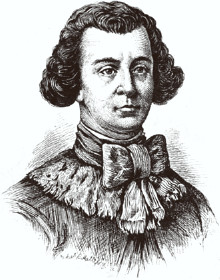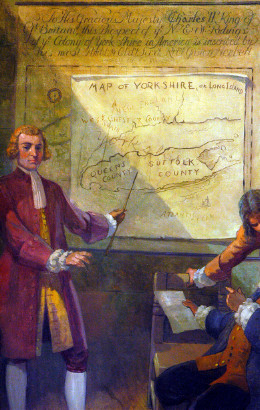
About Andrew Cusack
 Writer, web designer, etc.; born in New York; educated in Argentina, Scotland, and South Africa; now based in London.
Writer, web designer, etc.; born in New York; educated in Argentina, Scotland, and South Africa; now based in London. read more
News
Blogs
Reviews & Periodicals
Arts & Design
World
France
Mitteleuropa
Knickerbockers
Argentina
The Levant
Africa
Cape of Good Hope
Netherlands
Scandinavia
Québec
India
Muscovy
Germany
Academica
Thomas Dongan, 2nd Earl of Limerick
AS VIRGINIA, a year short of four centuries since her foundation, has only recently inaugurated her first Catholic governor, it might be an appropriate time to remember the first Catholic governor of New York, Thomas Dongan (right). Dongan’s tenure as Governor of the Province of New York was one of the most important in the history of our land, and witnessed the formative period of responsible government in what would eventually become the Empire State.
Thomas was born in 1634, the youngest son of Sir James Dongan, Bt., a Member of the Irish Parliament. After the regicide of Good King Charles in 1649, the Catholic family feared persecution and fled to France, as did the Royal Family. In France, having Gallicized his surname to D’Unguent, Thomas joined an Irish regiment and fought under the Vicomte de Turenne (who himself, born into Calvinism, became a Catholic in October 1668). Despite the Restoration of the Crown in Britain and Ireland, Dongan remained in France, being promoted to colonel in his fortieth year. The 1678 Treaty of Nijmegen, however, required all of Charles II’s subjects in the service of France to return home, and so Thomas obliged. Through the efforts of James, Duke of York, with whom Dongan had the privilege of serving in the French Army, he was granted a pension, a high-ranking commission, and was appointed Lieutenant-Governor of Tangiers, of all places, which (along with Bombay) had been given to England as part of the dowry of Catherine of Braganza.
It was in 1682 that James, Duke of York, as Lord Proprietor of New York, appointed Thomas Dongan to govern the bankrupt colony. “In this office,” the Catholic Encyclopedia says, “Dongan proved himself an able lawgiver, and left an indelible mark on political and constitutional history.” He convened the first representative assembly of the Province in 1683, which enacted the Charter of Liberties enunciating the form of government in New York. The Duke of York’s supreme legislative power as Lord Proprietor would reside in a governor, council, and general assembly. Members of the assembly were conferred rights and privileges making their august legislature coequal to and independent of Parliament. Courts of justice were established, liberty of conscience regarding religion was declared, and the principle of no taxation without representation was affirmed. Dongan signed the Charter of Liberties on 30 October 1683, and solemnly proclaimed it the next day at the Stadt Huys, New York’s city hall.
 “Thus to Dongan’s term as governor,” quoth the Encyclopedia, “can be dated the Magna Charta of American constitutional liberties, for his system of government became the programme of continuous political agitation by the colonists of New York Province during the eighteenth century. It developed naturally into the present state government, and many of its principles passed into the framework of the Federal Government. Moreover, a rare tribute to his genius, the government imposed by him on New York Province, 1683, was adopted by England after the American War of Independence as the framework of her colonial policy, and constitutes the present [1909] form of government in Canada, Australia, and the Transvaal.”
“Thus to Dongan’s term as governor,” quoth the Encyclopedia, “can be dated the Magna Charta of American constitutional liberties, for his system of government became the programme of continuous political agitation by the colonists of New York Province during the eighteenth century. It developed naturally into the present state government, and many of its principles passed into the framework of the Federal Government. Moreover, a rare tribute to his genius, the government imposed by him on New York Province, 1683, was adopted by England after the American War of Independence as the framework of her colonial policy, and constitutes the present [1909] form of government in Canada, Australia, and the Transvaal.”
The peace and harmony of the Province was furthered in 1684 when Dongan, in the presence of Lord Howard, the Governor of Virginia, received the voluntary submission of the Iroquois confederacy to “the Great Sachem Charles”. The following year saw the death of Charles II and the ascent of the Lord Proprietor, James, Duke of York, to the thrones of England, Scotland, and Ireland. In that year of 1685, Dongan established a Post Office to strengthen communications within his colony and between all the English colonies in America. In the next year, 1686, the Governor granted civic charters to New York and Albany. Dongan’s charter for the City of New York lasted 135 years, while that of Albany was only replaced in 1870. Avid historians would have been bemused/irritated by Archdiocese’s celebration just a few years ago of the two-hundredth anniversary of Catholic education in New York. This would be because New York’s first Catholic school was not in the 1800’s during the republic’s early years but in the 1680’s when Governor Dongan established a college (in the secondary sense) under the guidance of three Jesuit priests, one of whom was his own private chaplain.
Despite the brief attempt to merge New York and New England, followed by the overthrow of James, our last Catholic king, in the so-called ‘Glorious Revolution’, Governor Dongan’s legacy in establishing the institutions of responsible government in New York remains. Indeed he was unquestionably New York’s greatest governor until the advent of ‘Magnus Apollo’ himself, DeWitt Clinton, in the nineteenth century. With the new Protestant Williamite administration in charge, Thomas Dongan returned to England in 1691 and, with the death of his elder brother, inherited the Earldom of Limerick under its first (1686) creation. He died in 1715, poor and childless. Nonetheless, as the Encyclopedia notes:
The tribute of history to his personal charm, his integrity, and character, is outspoken and universal. His public papers give evidence of a keen mind and a sense of humour. He was a man of courage, tact, and capacity, an able diplomat, and a statesman of prudence and remarkable foresight. In spite of the brief term of five years as Governor of New York Province, by virtue of the magnitude, of the enduring and far-reaching character of his achievements, he stands forth as one of the greatest constructive statesmen ever sent out by England for the government of any of her American colonial possessions.
Search
Instagram: @andcusack
Click here for my Instagram photos.Most Recent Posts
- Burns Tower April 19, 2024
- Patrick in Parliament March 18, 2024
- Articles of Note: 13 March 2024 March 13, 2024
- Cambridge March 9, 2024
- Taken on Trust March 4, 2024
Most Recent Comments
Book Wishlist
Monthly Archives
Categories



